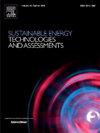利用滑动模式主动干扰抑制控制器对 PEM 燃料电池的供气进行解耦控制
IF 7.1
2区 工程技术
Q1 ENERGY & FUELS
Sustainable Energy Technologies and Assessments
Pub Date : 2024-10-22
DOI:10.1016/j.seta.2024.104051
引用次数: 0
摘要
供气子系统对于优化质子交换膜燃料电池(PEMFC)至关重要。本研究为空气子系统建立了一个瞬态模型,并提出了一种利用滑动模式主动干扰抑制控制(SM-ADRC)将空气压力和流量分离的控制策略。在本研究中,通过调整空气压缩机的转速和背压阀的开度来实现这一控制策略。滑动模式扩展状态观测器(SM-ESO)用于估计和补偿系统内的不确定性,而滑动模式非线性状态误差反馈(SM-NLSEF)则用于同时控制空气流量和压力。研究评估了 SM-ADRC 控制器在各种情况和环境压力下的性能。评估结果表明,SM-ADRC 控制器的性能明显优于模糊-ADRC、ADRC、SMC 和 PID 等传统方法,过冲分别减少了 18.2%、34.1%、42.5% 和 63.7%,调整时间也少于 1 秒。本文章由计算机程序翻译,如有差异,请以英文原文为准。
A decoupling control of air supply for the PEM fuel cell with slide mode-active disturbance rejection controller
The air supply subsystem is crucial for optimizing proton exchange membrane fuel cells (PEMFCs). This study develops a transient model for the air subsystem and proposes a control strategy that decouples air pressure and flow using sliding mode-active disturbance rejection control (SM-ADRC). In this study, adjustments to the air compressor speed and the opening of the back-pressure valve are utilized to achieve this control strategy. The sliding mode-extended state observer (SM-ESO) is employed to estimate and compensate for uncertainties within the system, while the sliding mode-nonlinear state error feedback (SM-NLSEF) is used to simultaneously control air flow and pressure. The study evaluates the performance of the SM-ADRC controller across various scenarios and environmental pressures. Evaluations show that the SM-ADRC controller significantly outperforms traditional methods like Fuzzy-ADRC, ADRC, SMC, and PID, with overshoot reductions of 18.2%, 34.1%, 42.5%, and 63.7%, respectively, and adjustment time under 1 s. Additionally, SM-ADRC achieves a 4.1% and 1.8% improvement in efficiency compared to PID and ADRC.
求助全文
通过发布文献求助,成功后即可免费获取论文全文。
去求助
来源期刊

Sustainable Energy Technologies and Assessments
Energy-Renewable Energy, Sustainability and the Environment
CiteScore
12.70
自引率
12.50%
发文量
1091
期刊介绍:
Encouraging a transition to a sustainable energy future is imperative for our world. Technologies that enable this shift in various sectors like transportation, heating, and power systems are of utmost importance. Sustainable Energy Technologies and Assessments welcomes papers focusing on a range of aspects and levels of technological advancements in energy generation and utilization. The aim is to reduce the negative environmental impact associated with energy production and consumption, spanning from laboratory experiments to real-world applications in the commercial sector.
 求助内容:
求助内容: 应助结果提醒方式:
应助结果提醒方式:


